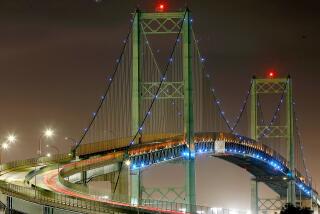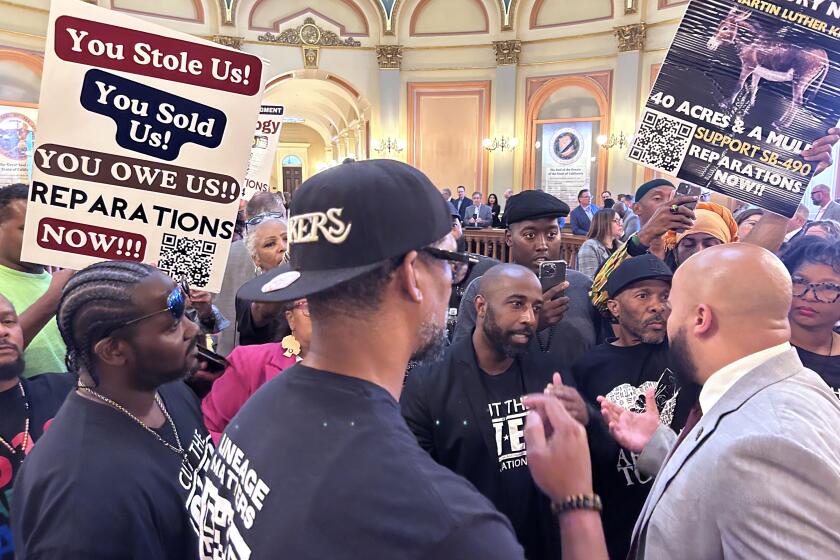New Signals Exceed First Estimate by $12 Million : Roads: The revised cost figure for their installation is ‘outrageous,’ Assemblyman Richard Katz says. Part of the blame is pinned on concrete below Ventura Boulevard.
- Share via
Installing state-of-the-art traffic signals in the San Fernando Valley, a project already delayed two years, will cost nearly 60% more than originally planned, city and state officials said Monday, sparking criticism of the planning involved.
Another $12 million is needed from the state to outfit all 360 intersections along the project’s route, increasing its cost from $20.7 million to $32.7 million, said Ed Rowe, general manager of the Los Angeles city Transportation Department.
Rowe attributed the increases to inflation, design changes, the fact that the signal system is so new, and the discovery of unexpected layers of concrete under Ventura Boulevard that have complicated installation of underground cables.
The project, scheduled for completion in 1992, covers a three-mile-wide corridor that stretches for more than 10 miles between Victory and Ventura boulevards. Designed to cut cross-Valley travel time, the Automated Traffic Surveillance and Control (ATSAC) program uses computerized signals that can respond to vehicle volume and flow as well as accidents.
The request for the additional funds, though submitted last spring, did not come to light until late last week when it was discovered by the staff of Assemblyman Richard Katz (D-Sylmar), who played a key role in arranging the original appropriations.
Katz reacted angrily to Rowe’s request for more funding from the California Transportation Commission. As chairman of the Assembly Transportation Committee, Katz is an ex-officio member of the Transportation Commission.
“I find it outrageous,” Katz said. “Unless they’re burning money down there it’s virtually impossible for a project like this to incur such a cost overrun, or the city Transportation Department has no clue what it’s doing.”
Katz said he had already recommended to the commission that the $12 million in state gas tax funds requested by Rowe be used for “other high priority” projects, such as widening California 14 through the eastern San Fernando and Antelope valleys.
The request is scheduled for a vote by the commission at its next monthly meeting Sept. 19-20. Although Katz has no vote, he can appeal directly to other commission members, and has done so in the past on Valley issues, said Peter Hathaway, the commission’s chief deputy director.
Los Angeles City Councilman Nate Holden, chairman of the council’s Transportation and Traffic Committee, also said he was concerned by the project’s cost overruns.
Holden said he had asked Rowe for a written report and would schedule transportation committee hearings on the increase if he was not satisfied by Rowe’s response.
“In my view, it’s pretty high. But before I attack him for poor judgment I want to hear his side of the story,” Holden said.
Rowe said he was still assessing the reasons for the flawed cost estimates but attributed them to two main factors: relying on the department’s limited experience with ATSAC systems in central Los Angeles and then running into more underground concrete than experienced previously beneath Ventura Boulevard.
Hathaway of the state commission said workers may have encountered more concrete beneath Ventura Boulevard than central Los Angeles service streets because the boulevard was built over what was once U.S. Highway 101, built during the 1930s before construction of the Ventura Freeway.
“That was an important route built to long-distance highway standards for use by trucks,” Hathaway said. “So, it would seem logical to me that the road was originally built to a thicker type of pavement than a city street would have been. I do not know that for a fact, but it seems logical to me that that would be the case.”
If no one in the city Transportation Department remembered Highway 101, Hathaway said, researching old road maps or conducting test drills would have revealed its presence and the need for higher cost estimates.
Rowe acknowledged that more research and tests could have been conducted before submitting his department’s original cost estimates. “But this was at the very early preliminary planning stage,” he said, “and we were under considerable pressure to come up with a cost on a very fast basis.
“So we did it on the basis of the best experience to date.”
To save time, he said, his staff used the bids from the central Los Angeles projects--one in the central business district and the other for the 1984 Olympics Coliseum route--and tried to update them.
Hathaway agreed that the ATSAC traffic-signal system is very new and has been installed in only a few cities across the country, “so there isn’t a long track record for this particular type of project and when doing something kind of new unforeseen problems come up.”
He said the Transportation Commission would receive the staff’s recommendation on Rowe’s funding request this weekend, along with recommendations for scores of other transportation projects. He declined to reveal the recommendation before it was received by commissioners.
More to Read
Sign up for Essential California
The most important California stories and recommendations in your inbox every morning.
You may occasionally receive promotional content from the Los Angeles Times.










